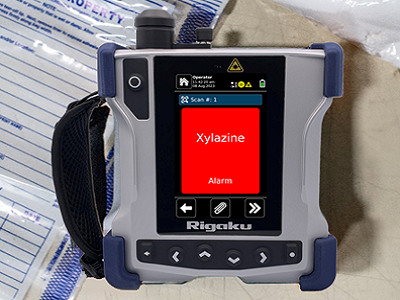Application Note RAD9130
Despite educational efforts and policies by local and civil governments, drug use continues to climb in many regions of the world. The United Nations 2023 World Drug Report states that “estimated number of [worldwide drug] users grew from 240 million in 2011 to 296 million in 2021 … a 23% increase.”1 The illicit drugs used vary by region, but the top drug categories include methamphetamines, opioids, cocaine and novel psychoactive substances for Asia, Europe, Latin America and North America respectively. For scale, INTERPOL Secretary General Stock noted that in April 2023, “Over the last five years, [drug] trafficking and consumption have increased by an order of magnitude,” noting that in Central and South America over $5.7 billion in illegal narcotics had been seized in anti-trafficking operations.2 In California, the amount of fentanyl seized in 2023 was 1066% more than that seized just two years prior.3 The increasing prevalence of drug use and trafficking worldwide, necessitates that rapid narcotics identification is a critical component to all areas of narcotics interdiction.
Advantageous Presumptive Identification
The advent of handheld analytical technologies has provided law enforcement with new and robust tools for safer and more rapid identification and classification of illicit materials seized. Presumptive identification of seized materials aids authorities in correct apprehension, tracking trafficking and raw material routes, and expediates prosecution. Drugs that are contact and inhalation hazards make non-contact methods of classifying these materials beneficial. Traditional wet-chemistry methods require material contact, which poses higher risk than non-contact analysis. Wet-chemistry tests are sample destructive and have known false positives on non-threat materials, leading to expensive and undue remediation efforts.
 Figure 1. Rigaku’s CQL Narc-ID screens are easy to read and are unambiguous in displaying the material identified and appropriate threat (or non-threat) category.
Figure 1. Rigaku’s CQL Narc-ID screens are easy to read and are unambiguous in displaying the material identified and appropriate threat (or non-threat) category.
Rigaku CQL Narc-ID Handheld Raman Provides Narcotics Analysis
Rigaku’s handheld CQL Narc-ID Raman instrumentation is designed detection of narcotics by law enforcement. A non-contact method, CQL Narc-ID’s laser-based analysis permits users to identify unknown materials through translucent containers. This reduces the risk of accidental exposure to pure and mixtures of drugs or other chemicals that present health hazards to law enforcement. The CQL Narc-ID’s customized library also contains reference data for narcotic cutting agents, precursor materials and legal pharmaceutical agents. Using 1064 nm excitation, the CQL Narc-ID helps mitigate fluorescence often associated with narcotics analysis by other handheld Raman instrumentation. CQL Narc-ID’s specialized algorithm provides a prioritized output to users, indicating if a threat is present, even if there are non-threat components present in a mixture.

Figure 2. Actual CQL Narc-ID hits from forensic laboratory samples tested. Note that in the left most screen, two illicit substances were found, and are prioritized to the user as alarms compared to the rest of the sample (~35% cutting agent).
The CQL Narc-ID was used to test seized narcotics samples. The majority of the samples had been processed by other confirmatory analytical methods for reference prior to Rigaku testing them. Many samples had illicit content that was greater than 10% of the total mixture volume, although some mixtures had illicit materials comprising less than 10% of the total mixture, while some were legitimate pharmaceutical drugs. Eight-five samples were examined during this testing. Figure 2 shows some of the illicit materials encountered during this testing. The Narc-ID GUI is designed for ease of use, with intuitive menus and command prompts, easy to read results, and prioritization of alarm materials to the user. All samples with meaningful spectra correctly hit for illicit drugs or respective cutting agents (if the sample was found to be benign). Figure 3 shows an example of the multi-narcotic hit of CQL Narc-ID on one of the seized samples tested.

Figure 3. Spectral output of a seized narcotics sample containing Acetyl Fentanyl HCl and Xylazine HCl. Both threat materials appeared on the GUI output.
Conclusion
The increasing prevalence of drug use and trafficking worldwide underscores the urgent need for advanced narcotics detection methods. Rigaku’s CQL Narc-ID handheld Raman instrumentation emerges as a pivotal tool in this battle, offering law enforcement a safer, more efficient means of identifying illicit substances without direct contact. As demonstrated in the testing of seized samples, CQL Narc-ID’s robust performance and user-friendly interface make it an indispensable asset in the ongoing fight against drug-related crimes, ultimately contributing to more effective interdiction and prosecution efforts.
References
1UNODC. https://www.unodc.org/res/WDR-2023/WDR23_Exsum_fin_DP.pdf Retrieved on 19 Feb. 24
2INTERPOL. https://www.interpol.int/News-and-Events/News/2023/Europe-Drug-trafficking-organized-crime-increasing-by-an-order-of-magnitude Retrieved on 19 Feb. 24
3https https://www.gov.ca.gov/2024/02/27/california-seizes-record-62000-pounds-of-fentanyl/ Retrieved on 19 Feb. 24



